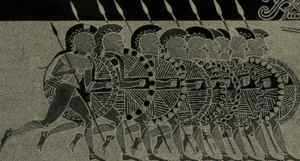Articles >>
Phalanx
Category: Term of the day

A phalanx (plural phalanxes or phalanges) is a rectangular mass military formation, usually composed entirely of heavy infantry armed with spears, pikes, or similar weapons. The troops were disciplined to hold a line which created a nearly impenetrable forest of points to the front. The phalanx is a hallmark of ancient Greek warfare. The word phalanx is derived from the Greek word phalangos, meaning the finger. The (hoplite) phalanx was a formation in which the hoplites would line up in ranks, usually no less than four deep, in very close order. In this formation, the hoplites would lock their shields together, and the first few ranks of soldiers would project their spears out over the first rank of shields, to try to gain the upper hand in the battle early on and as a result, allowing for the first three or so ranks of spearmen to engage their spears against the enemy. Therefore, one might say that the phalanx was essentially a formation in which the hoplites created a mass spear and shield wall. The effectiveness of the phalanx depended upon how well the hoplites could maintain this formation while in combat, and how well they could stand their ground, especially when engaged against another phalanx. It could be said that the main enemy of a phalanx was not the opposition forces (the majority of the soldiers would remain unengaged in a phalanx versus phalanx pushing match, because they were positioned at the rear and were responsible for keeping the front rows pressed forward) but fear. One theory was that the more disciplined and courageous the army the more likely it was to win - often scrims between the various city-states of Greece would be resolved by one side fleeing before the engagement. The Greek word dynamis, the "will to fight", expresses the drive that kept hoplites in formation. Before the advance, both sides would sing the 'paean', the battle-hymn (notably, the Spartans rejected the use of a battle-hymn, thinking it needless bravado), then advance to the cadence (a marching beat) - on trumpets, pipes or drums. When nearing the enemy, the phalanx would break into a run that was sufficient enough to create momentum but not too much as to lose cohesion. Both sides would collide viciously, breaking many of the spears of the front row. The battle would then rely on the valour of the men in the front line and the rear men to maintain a push forward with their shields. The natural tendency during battle would be to drift towards the right side, or even for both lines to "wheel" as one side gave ground and the other advanced. This is because the individual hoplites carried their shields on their left arm, protecting not themselves but the soldier to the left (thus giving an incentive to stand very close together). Battles were won when the exposed right side (carrying spears) could overpower the opposing army's left side (carrying shields). When in combat, the whole formation would consistently press forward trying to break the enemy formation; thus when two phalanx formations engaged, the struggle essentially became a pushing match, in which, as a rule, the deeper phalanx would almost always win, with very few recorded exceptions. |
Sarissa
18.04.2013
Valanx Unveiled In Australia
25.11.2010
Asymmetric Warfare
31.07.2008
Hoplite
24.09.2007
Phalanx Defense Systems, L.L.C.
Phalanx Armor System (Protective screen)
Discuss
